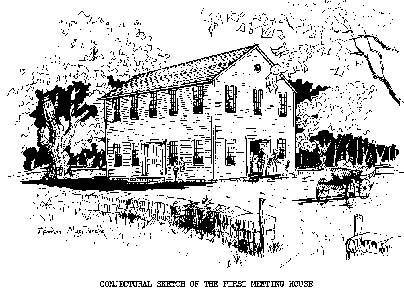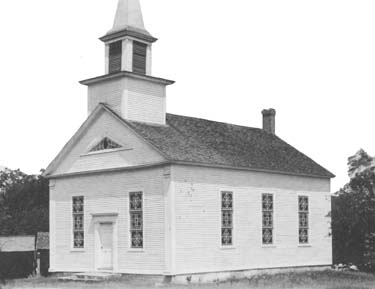Churches
By Scott Yeomans
Copyright Scott Yeomans, 1998
Congregational
In November, 1747, the members of the newly formed Andover Ecclesiastical Society voted to hire a minister for the winter. Thus marked the gathering of the church. Initially, worship services were held in various homes in the parish. The official organization of the church, the adoption and signing of the Creed and Covenant, occurred on February 14, 1748/9.
At this time, civil affairs were second to religious matters. An area could not become a town unless it was first an ecclesiastical society. Every household in the parish, with the exception of professed Anglicans, were taxed to support the church and minister, whether they were members of the church or not. Prior to 1770, Connecticut law called for a fine of 10 shillings for any church member being absent from public worship without a proper excuse. No travel, other than to and from the meeting house was allowed on the Lord's day.
In March, 1748, a young minister named Samuel Lockwood was invited "to preach the gospel for the space of nine Sabbaths." So impressed were the people of Andover Society that immediately following this, it was the unanimous vote of the parishioners to hire Mr. Lockwood as a probationer. Two months later it was voted to settle the Minister permanently. Rev. Lockwood served Andover until his death in 1791.
In June, 1748, at a Society meeting that was "adjourned to Phelp's barn" those present voted to hire Mr. Tarbox of Hebron for two days to "raise our meeting house; to pay Mr. Ebenezer Leach 110 pounds for framing it." This building was on what today is Hebron Road, about mid-way between Boston Hill Road and Center Street. The land, with sufficient room for the meeting house and a drill yard, plus roads leading to it, was received from Aaron Phelps. Mr. Phelp's house and barn were frequently used for worship services and Society meetings prior to the reading of the meeting house. Due to various circumstances, the building would not be finished for nearly 20 years. However, it was in use long before it was finished. Even when completed, it was quite common to adjourn to some nearby house during the winter months because of the lack of any heat in the building.
Worship services were all day affairs. The people were called to worship by the beating of drums. After the parishioners were seated the minister would walk to the elevated pulpit and begin his hours long service. After an intermission at noontime, the people would return for more hours of worship. Special sentries were posted with long poles to prod anyone who should fall asleep during the services. In November, 1792, the Society voted to have a one hour intermission from October 1 to March 31 and a two hour intermission for the rest of the year. The intermission was a time to lunch and socialize. As early as 1752 the society gave permission to those who wanted, to build stables and small houses of 12 foot width on the southeast side of "meeting house green." These "nooning houses" were used for the comfort of the parishioners who lived too far from the meeting house to go home during the intermission. Having endured 3 to 4 hours of preaching in the morning and looking forward to many more afternoon hours of sermons, these small houses provided a place to lunch and relax. Some even had a chimney so that a warming fire could be made to thaw people out before returning to the unheated meeting house.
Andover, like most other New England parishes, began by seating men and women separately during services. But, by the close of 1752, the congregation voted to "seat men and women together in the pues." Seats were assigned, with fines levied against anyone taking a seat other than the one specified for them. The formulas and committees that determined the seating arrangements were a constant source of controversy.
In 1831 a committee was established to determine the probable expense that would be incurred to repair the meeting house and to estimate the cost of building a new one. In November, 1832 the Society resolved "this Ecclesiastical Society should build a new house for public worship; that a subscription of not less than $1,800 should be raised to accomplish this purpose." The new building was dedicated on September 28, 1833. Built on land donated by Leonard Hendee, the new church cost $2,103. In 1869 the main building underwent extensive renovations and was rededicated with great fan-fare. Another major event was the arrival of a bell for the steeple. A gift of the "Helping Hands" group, the bell was cast in Baltimore and shipped via the railroad to Andover station in 1884. It was then hauled down to the church and lifted to its perch in the steeple. The treasurers report now shows an entry, "to Henry Dorrance $10 a year for ringing the bell." In 1958, an addition was made to the church building which extended the sanctuary and social room, added four classrooms and a new kitchen.
With many of its duties now carried out by the town and the rest being matters of the church, the Andover Ecclesiastical Society was dissolved on 6/19/1953. All of its remaining duties and assets were formally transfered to the church.
Baptist -
"At a meeting of a number of Dissenters in the Society of Andover on the 9th day of October 1805 for the purpose of forming and uniting themselves in one Religious Society to be denominated a Baptist Society." Thus begin the Andover Baptist Ecclesiastical Society records. It was not long before this Society numbered about 50 people from Andover and the other surrounding Societies. With such numbers it was felt that they were capable of raising the funds necessary to erect and support a meeting house. So, in 1825 a committee consisting of John Payne, Simon House, Aaron White, Nathan Lyman, William Carver, Leonard Hendee and Ebenezer Loomis was given the task of procuring a spot suitable for the construction of same. Nothing much happened until January of 1831 when the Society voted to accept of Simon House, a gift of land. The building pictured here was then erected, with the first meeting in it being held on October 20, 1831.
This building was located across Route 6 from where the town hall is today. The step stone that is visible in the photograph is still there to mark the spot. Between 1960 and 1992 this stone served as the foundation for the Korean and WWII monument. The Baptist Society dissolved itself in early 1899. Sometime after, the Church sold the building and property to the Town, which used it as a gymnasium. Eventually the building was not even suitable for basketball and was torn down in 1932.
To Return to the Main History Menu




